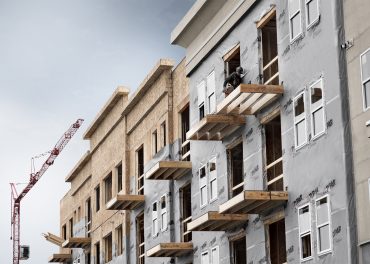
canadiancontractor
Evaluating drainable building wraps
There are many different drainable building wrap products available on the market today. Here are a few tips for selecting the right one for your project.
This is a sponsored post, courtesy of TYPAR
At the cutting edge of building wrap technology are many new products that add bulk water drainage to an already potent mix of weather resistive properties. From products that feature dimples or spacers to those with integrated rainscreens, builders and contractors have more choices than ever for keeping buildings dry.
With so many options to choose from, how do you know what type of weather protection is best for your project?
 A key consideration is the type of cladding being used. When installing vinyl siding, which has built-in drainage holes and fits loosely on the wall, an ordinary smooth-faced building wrap should provide adequate drainage. However, tightly fastened cladding such as cedar siding or fiber cement board might allow water trapped between the siding and a smooth building wrap to pool and could eventually make its way through the building wrap and into the framing. These are cases where a drainable wrap would provide significant benefit.
A key consideration is the type of cladding being used. When installing vinyl siding, which has built-in drainage holes and fits loosely on the wall, an ordinary smooth-faced building wrap should provide adequate drainage. However, tightly fastened cladding such as cedar siding or fiber cement board might allow water trapped between the siding and a smooth building wrap to pool and could eventually make its way through the building wrap and into the framing. These are cases where a drainable wrap would provide significant benefit.
Reservoir claddings such as brick, stucco and stone present another set of issues. Because these materials hold water, once they get wet the stored water can migrate elsewhere and cause problems. In these applications, it is imperative to separate the cladding from the rest of the assembly with a capillary break, which can be an airspace or a material that sheds water or does not absorb or pass water.
Geography and climate are important, as well, specifically as it relates to annual rainfall. As a rule of thumb, the Building Enclosure Moisture Management Institute recommends that any area receiving more than 20 inches of annual rainfall should incorporate enhanced drainage techniques, especially if using an absorptive cladding material, while areas receiving 40 inches or more should utilize rainscreen design regardless of cladding material. The geographic orientation of the wall, amount of overhang, altitude, and even nearby trees can also have an impact on how much water intrusion can be expected and how likely it is to dry.
While we can’t completely stop water from getting into walls, advances in building wrap technology are a welcome way to help ensure potential damage from water intrusion is mitigated. And with a variety of drainable products to choose from, builders and contractors have many ways to keep walls dry in any climate or condition.

Leave a Reply